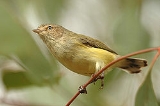
Weebill
Encyclopedia
The Weebill is Australia
's smallest bird at approximately 9 cm long. It is an olive-yellow songbird
with a grey bill
, brown wings, pale yellow eyes and grey feet. Its tail feathers are brown with a black bar and white spot on the tip of all inner webs but the central pairs. The sexes are similar. The Weebill is the only member of genus Smicrornis; gene flow
is strong and local variation follows Bergmann's
and Gloger's Rule
s.
The Weebill is found in woodland
s and forests throughout mainland Australia
. The diet consists mostly of insect
s and larvae. The female usually lays two or three brown-speckled cream-colored eggs
.
Widespread and common in its habitat throughout its range
, the Weebill is evaluated as Least Concern on the IUCN Red List
of Threatened Species.
Australia
Australia , officially the Commonwealth of Australia, is a country in the Southern Hemisphere comprising the mainland of the Australian continent, the island of Tasmania, and numerous smaller islands in the Indian and Pacific Oceans. It is the world's sixth-largest country by total area...
's smallest bird at approximately 9 cm long. It is an olive-yellow songbird
Songbird
A songbird is a bird belonging to the suborder Passeri of the perching birds . Another name that is sometimes seen as scientific or vernacular name is Oscines, from Latin oscen, "a songbird"...
with a grey bill
Beak
The beak, bill or rostrum is an external anatomical structure of birds which is used for eating and for grooming, manipulating objects, killing prey, fighting, probing for food, courtship and feeding young...
, brown wings, pale yellow eyes and grey feet. Its tail feathers are brown with a black bar and white spot on the tip of all inner webs but the central pairs. The sexes are similar. The Weebill is the only member of genus Smicrornis; gene flow
Gene flow
In population genetics, gene flow is the transfer of alleles of genes from one population to another.Migration into or out of a population may be responsible for a marked change in allele frequencies...
is strong and local variation follows Bergmann's
Bergmann's Rule
Bergmann's rule is an ecogeographic principle that states that within a broadly distributed genus, species of larger size are found in colder environments, and species of smaller size are found in warmer regions. Although originally formulated in terms of species within a genus, it has often been...
and Gloger's Rule
Gloger's rule
Gloger's Rule is a zoological rule which states that within a species of endotherms, more heavily pigmented forms tend to be found in more humid environments, e.g. near the equator. It was named after the zoologist Constantin Wilhelm Lambert Gloger, who first remarked upon this phenomenon in 1833...
s.
The Weebill is found in woodland
Woodland
Ecologically, a woodland is a low-density forest forming open habitats with plenty of sunlight and limited shade. Woodlands may support an understory of shrubs and herbaceous plants including grasses. Woodland may form a transition to shrubland under drier conditions or during early stages of...
s and forests throughout mainland Australia
Australia
Australia , officially the Commonwealth of Australia, is a country in the Southern Hemisphere comprising the mainland of the Australian continent, the island of Tasmania, and numerous smaller islands in the Indian and Pacific Oceans. It is the world's sixth-largest country by total area...
. The diet consists mostly of insect
Insect
Insects are a class of living creatures within the arthropods that have a chitinous exoskeleton, a three-part body , three pairs of jointed legs, compound eyes, and two antennae...
s and larvae. The female usually lays two or three brown-speckled cream-colored eggs
Bird egg
Bird eggs are laid by females and incubated for a time that varies according to the species; a single young hatches from each egg. Average clutch sizes range from one to about 17...
.
Widespread and common in its habitat throughout its range
Range (biology)
In biology, the range or distribution of a species is the geographical area within which that species can be found. Within that range, dispersion is variation in local density.The term is often qualified:...
, the Weebill is evaluated as Least Concern on the IUCN Red List
IUCN Red List
The IUCN Red List of Threatened Species , founded in 1963, is the world's most comprehensive inventory of the global conservation status of biological species. The International Union for Conservation of Nature is the world's main authority on the conservation status of species...
of Threatened Species.
External links
- BirdLife Species Factsheet
- Flickr Field Guide Birds of the World: Smicrornis brevirostris. Retrieved 2007-JUL-09.

